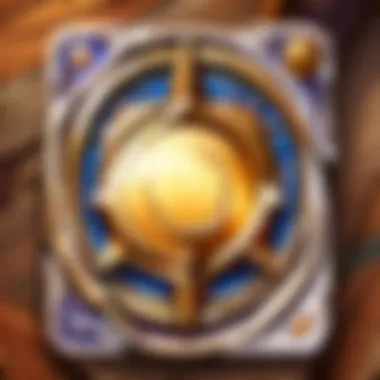Mastering the Art of Hearthstone Deck Building: A Comprehensive Guide


Game Updates and Patches
Hearthstone, a dynamic card game, frequently undergoes updates and patches to enhance gameplay and introduce new content. Keeping abreast of these changes is essential for players striving to build competitive decks. The latest updates often bring adjustments to card abilities, mana costs, and overall game mechanics. Understanding and adapting to these modifications are integral to successful deck construction.
Deck Strategies and Meta Analysis
Navigating the intricate landscape of deck strategies and the current meta is crucial for Hearthstone players aiming for success. Different playstyles require tailored deck recommendations, whether aggressive, control-oriented, or combo-focused. By analyzing popular deck archetypes and the current meta trends, players can gain valuable insights into effective strategies and optimal tech choices to counter prevalent decks.
Card Reviews and Set Reviews
Delving into comprehensive card reviews and set evaluations provides players with a nuanced understanding of card synergies and competitive viability. Assessing new cards for their potential impact on the meta landscape is pivotal for successful deck building. Evaluating card sets based on their value, versatility, and strategic implications allows players to make informed decisions when constructing decks.
Player Guides and Tips
Providing a solid foundation for players of all skill levels, Hearthstone player guides offer valuable insights into core game mechanics and essential strategies. Advanced tips focus on enhancing gameplay mechanics and decision-making processes, enabling players to refine their skills and elevate their performance. In addition, specialized strategies for Arena drafting and gameplay offer players the tools needed to excel in this competitive format.
Introduction
Deck building in Hearthstone is a crucial aspect that can determine the outcome of your matches. Understanding the intricacies of constructing a deck is akin to wielding a powerful tool in your arsenal, capable of leading you to victory or defeat. In this guide, we delve deep into the art and science of deck building, unraveling its complexities and offering insights that will elevate your gameplay to new heights.
What is Hearthstone Deck Building?
Deck building defined
Hearthstone deck building is the strategic process of selecting individual cards to form a cohesive deck that synergizes well for optimal performance. This meticulous crafting of your deck forms the foundation of your gameplay strategy, determining your ability to adapt to various situations and outmaneuver your opponents. Emphasizing the creation of a well-balanced deck is key to success in Hearthstone, ensuring that every card contributes meaningfully to your overall game plan. The flexibility and creativity afforded by deck building make it a popular and rewarding aspect of the game, offering players a personalized approach to their gameplay.
Importance of deck building
The importance of deck building cannot be overstated in Hearthstone. A well-constructed deck is your pathway to success, enabling you to execute your strategic vision with precision and efficiency. Deck building allows players to tailor their decks to suit their playstyle, capitalize on their strengths, and cover their weaknesses. By understanding the nuances of deck building, players can cultivate a deep sense of mastery over their cards, honing their skills to reach higher levels of gameplay proficiency.
Overview of Hearthix Portal
Brief description of Hearthix
Hearthix Portal serves as a comprehensive platform where Hearthstone enthusiasts can gather valuable insights, strategies, and community-driven content. This centralized hub offers a vast array of resources, ranging from deck building guides to meta analyses, catering to players of all skill levels. The intuitive interface and user-friendly design of Hearthix make it a go-to destination for Hearthstone players seeking to enhance their gameplay experience.
Target audience of Hearthix
The target audience of Hearthix encompasses both novice and seasoned Hearthstone players alike. Whether you're looking to sharpen your deck building skills or stay updated on the latest meta trends, Hearthix caters to a diverse audience with varying interests and objectives in the game. From beginners seeking fundamental strategies to veteran players exploring advanced techniques, Hearthix provides a wealth of information to enrich the Hearthstone community.
Purpose of the Article


Educate players on deck building
One of the primary objectives of this article is to educate players on the core principles of deck building in Hearthstone. By guiding players through the fundamentals of constructing a cohesive deck, we aim to empower individuals to make informed card choices, understand synergy dynamics, and develop strategic thinking skills essential for deck optimization. Through a systematic exploration of deck building concepts, players can elevate their gameplay and embark on a journey of continuous improvement.
Provide strategic insights
In addition to imparting foundational deck building knowledge, this article seeks to provide players with strategic insights that can enhance their decision-making processes. Delving into advanced strategies, meta analyses, and tech choices, we aim to equip players with the analytical tools needed to adapt to evolving metagames, counter prevalent strategies, and navigate complex gameplay scenarios. By offering strategic guidance and thought-provoking insights, we foster a culture of strategic depth and critical thinking within the Hearthstone community.
Fundamentals of Deck Building
In the realm of Hearthstone deck construction, mastering the fundamentals is akin to laying a solid foundation for a towering structure. These fundamental principles serve as the cornerstone, dictating the direction and feasibility of your deck. Understanding the card basics and deck archetypes is crucial in navigating the complex ecosystem of Hearthstone strategies. As players delve into the nuances of deck building, concepts like card synergies and strategic considerations come into play, elevating their decks from mundane to magnificent.
Card Basics
Understanding Card Types
Within Hearthstone, discerning the intricacies of diverse card types forms the bedrock of deck building proficiency. By comprehending the distinctions between minions, spells, and weapons, players can manipulate their deck composition for optimal performance. The strategic deployment of these card types hinges on factors like mana cost, utility, and synergistic potential, shaping the deck's overarching strategy. Grasping the nuances of card types equips players with the acumen to craft decks tailored to their preferred playstyle, whether it be aggressive, defensive, or combo-oriented.
Mana Curve
The mana curve stands as a pivotal aspect of deck construction, determining the flow and tempo of gameplay. Balancing the distribution of cards across various mana costs is crucial for maintaining a steady stream of plays throughout the match. A well-structured mana curve ensures that players have access to plays at every stage of the game, preventing lulls in their gameplay. By strategizing around the mana curve, players can overcome early-game aggression, establish mid-game dominance, and secure late-game victory, thus solidifying their deck's resilience and adaptability.
Deck Archetypes
Aggro Decks
Aggro decks embody a relentless offensive strategy, prioritizing swift damage output and board control. By flooding the board with low-cost, high-impact minions, aggro decks apply consistent pressure on opponents, forcing them into a defensive stance. The key strength of aggro decks lies in their ability to dictate the pace of the game, pressuring opponents to react hastily or fall behind irreversibly. However, aggro decks are susceptible to board clears and taunt minions, requiring players to execute their strategy with precision and foresight.
Control Decks
Contrasting the aggression of aggro decks, control decks emphasize defensive tactics and resource management. By employing board clears, healing effects, and late-game powerhouses, control decks aim to survive the opponent's onslaught and outvalue them in the late game. The resilience of control decks lies in their capacity to weather early-game aggression and establish a dominant position as the match progresses. Control decks excel in extended matches where patience and long-term planning are rewarded, offering a strategic playground for tactically minded players.
Combo Decks
At the intersection of synergy and timing, combo decks shine as intricate puzzles waiting to be solved. These decks revolve around assembling specific combinations of cards to unleash devastating effects or achieve unbeatable board states. The allure of combo decks stems from their explosive potential, capable of turning the tide of a match in a single, well-coordinated sequence. However, mastering combo decks necessitates meticulous planning, precise card sequencing, and vigilant anticipation of opposing strategies.
Card Synergies
Synergy Between Cards
Unleashing the true power of a deck hinges on identifying and harnessing the synergies between its constituent cards. Card synergies amplify individual card effects, transforming them into formidable combos that can swing the momentum of a match. By strategically pairing cards that complement each other's strengths and mitigate weaknesses, players can unleash synergistic chains of plays that catch opponents off guard and secure victory. The mastery of card synergies elevates deck building from a mechanical task to an artistic endeavor, where creativity and foresight breed innovation and success.
Building Around Themes


Thematic deck building offers players a canvas to express their creativity and strategic vision. By centering their deck around a specific theme or playstyle, players can unify card choices, synergies, and win conditions into a cohesive strategy. Whether embracing tribal synergy, spell-centric gameplay, or unique win conditions, building around themes infuses decks with character and narrative, making each victory a testament to the player's ingenuity and adaptability. The thematic approach to deck construction adds depth and personality to gameplay, rewarding players who dare to step beyond conventional strategies and explore uncharted territories.
Advanced Strategies
In the realm of Hearthstone deck building, Advanced Strategies stand as a pivotal element that separates amateurs from experts. These strategies delve into the intricacies of the game, offering players a deeper understanding of how to craft decks that can outsmart opponents and adapt to varied scenarios. By mastering Advanced Strategies, players can anticipate their opponents' moves, counter popular meta decks effectively, and ultimately increase their win rate significantly.
Tech Cards
Incorporating Tech Cards
When it comes to Incorporating tech cards into your deck, the key lies in strategic adaptability. Tech cards are specialized cards that are not part of the core strategy of your deck but are included to target specific threats or opportunities prevalent in the meta. By incorporating tech cards intelligently, players can gain a crucial edge over opponents by countering popular strategies or bolstering their own weaknesses. The unique feature of tech cards is their versatility, allowing players to tailor their deck to the ever-evolving meta, although this adaptability also comes with the risk of diluting the deck's primary strategy.
Countering Meta Decks
Countering meta decks is a fundamental aspect of competitive play in Hearthstone. By understanding the popular strategies and tactics dominating the meta, players can effectively counter these prevalent decks by incorporating specific tech cards and adapting their gameplay. This approach enables players to disrupt the rhythm of their opponents, capitalize on weaknesses in popular meta decks, and consistently deliver unexpected plays. While countering meta decks can be highly rewarding, it also requires thorough research and strategic foresight to ensure that the tech choices align with the anticipated matchups.
Value and Tempo
Understanding Value Plays
The concept of Value Plays revolves around maximizing the efficiency of each card played. By assessing the value of card interactions and making optimal trades, players can generate incremental advantages that snowball into significant leads over time. Understanding value plays empowers players to make informed decisions that prioritize long-term benefits over short-sighted gains, laying the foundation for consistent success. The key characteristic of value plays is the emphasis on resource optimization, allowing players to utilize their cards to their full potential and outvalue opponents in the long run.
Tempo Considerations
Tempo considerations in Hearthstone refer to the strategic management of board presence and initiative. By maintaining tempo, players can dictate the pace of the game, forcing opponents to react defensively and limiting their options. Acknowledging tempo considerations involves balancing aggression with restraint, knowing when to press an advantage and when to hold back to avoid overcommitting. The unique feature of tempo considerations is their dynamic nature, requiring players to adapt their gameplay based on the evolving board state and strategic priorities. While prioritizing tempo can lead to swift victories, it also necessitates careful planning to avoid falling behind if the initial aggressive push falters.
Mulligan Strategies
Optimizing Starting Hand
Optimizing the starting hand is a crucial aspect of deck building that sets the tone for the entire match. By strategically selecting mulligan options that align with the deck's game plan, players can increase the likelihood of drawing essential cards and establishing a strong early game presence. The key characteristic of optimizing the starting hand lies in foresight and preparation, anticipating the ideal curve and synergies that will propel the deck towards victory. However, while optimizing the starting hand can provide a strategic advantage, it also carries the risk of drawing suboptimal cards that may hinder early game momentum.
Adapting to Matchups
Adapting to matchups is a dynamic skill that distinguishes adept players from the rest. By recognizing the strengths and weaknesses of their deck against specific archetypes, players can tailor their gameplay and card choices to gain a strategic edge. Adapting to matchups involves analyzing opponents' strategies, predicting their likely responses, and adjusting one's gameplay to exploit vulnerabilities effectively. The unique feature of adapting to matchups is the versatility it offers, allowing players to pivot their tactics on the fly and maximize their chances of success in diverse scenarios. While adapting to matchups can be a game-changer, it demands quick thinking and adaptability under pressure to read opponents accurately and make timely adjustments.
Deck Optimization
Deck Optimization plays a pivotal role in enhancing a Hearthstone player's gameplay. It involves meticulously refining a deck to ensure its efficiency and effectiveness during matches. By optimizing a deck, players can improve their win rate and adapt to different gaming scenarios. Deck Optimization encompasses several crucial elements, including card selection, mana curve balancing, and synergies between cards. These aspects are essential for creating a well-rounded and competitive deck that can stand against various opponents.
Testing and Refining
Playtesting techniques


Playtesting techniques are fundamental in honing a deck to perfection. Conducting rigorous playtesting allows players to assess the deck's performance under different circumstances and identify its strengths and weaknesses. By repeatedly testing the deck in actual gameplay, players can fine-tune card choices, adjust the mana curve, and evaluate synergies between cards. This methodical approach aids in understanding how the deck functions in practice, enabling strategic adjustments to optimize its performance.
Identifying weaknesses
Identifying weaknesses within a deck is paramount for effective deck optimization. By recognizing weak links or inconsistencies in the deck's strategy, players can address vulnerabilities and enhance overall performance. This process involves scrutinizing gameplay data, analyzing losing patterns, and pinpointing cards or strategies that underperform. Through thorough identification of weaknesses, players can make informed decisions in refining their deck, ultimately strengthening its competitive edge.
Meta Adaptation
Keeping up with meta shifts
Adapting to meta shifts is crucial in Hearthstone deck building. The game's meta, which refers to popular strategies and dominant decks in the current environment, constantly evolves. By staying abreast of these changes, players can adjust their deck composition to counter prevalent strategies and capitalize on emerging trends. Regularly analyzing the meta allows players to anticipate opponent strategies, make strategic tech choices, and refine their deck for optimal performance.
Flexibility in deckbuilding
Flexibility in deckbuilding is a valuable trait for successful Hearthstone players. A flexible deck can swiftly adapt to different matchups and meta landscapes, ensuring adaptability in various gaming scenarios. Players with versatile decks can modify card choices, incorporate tech cards, and adjust their strategy on the fly. This adaptability grants players a strategic advantage, as they can tailor their deck to counter specific threats or exploit opponent weaknesses effectively.
Tech Choices
Meta-dependent tech cards
The inclusion of meta-dependent tech cards is a strategic decision that can significantly impact a deck's performance. Tech cards specifically tailored to counter popular decks or prevalent strategies in the meta can bolster a player's chances of success. By incorporating these reactive cards, players can gain a competitive edge against common archetypes and unexpected threats. However, the effectiveness of meta-dependent tech cards relies on accurately predicting the meta and making timely adjustments to optimize their impact.
Optimal tech inclusions
Choosing optimal tech inclusions is a balancing act that requires careful consideration of the deck's overall strategy and prevalent meta trends. Optimal tech cards offer versatile solutions that can address multiple threats while synergizing effectively with the deck's core strategy. Selecting tech cards that complement the deck's strengths and shore up its weaknesses is essential for achieving consistent performance across diverse matchups. By strategically integrating optimal tech choices, players can fine-tune their deck for maximum efficiency and competitiveness.
Conclusion
In the vast landscape of Hearthstone deck building, the Conclusion section serves as the pivotal point where all the knowledge and strategies discussed in this comprehensive guide converge. It encapsulates the essence of creating powerful and effective decks by emphasizing the significance of synergy and adaptability. This final segment aims to instill in players the importance of continuous learning and experimentation to evolve as skilled Hearthstone competitors. By synthesizing the key learnings and insights provided throughout the article, the Conclusion acts as a compass, guiding players towards deck construction excellence.
Summary of Key Points
Importance of Deck Synergy
Deck synergies lie at the heart of successful deck building in Hearthstone. The intricate interplay between cards, creating powerful and cohesive combinations, sets the foundation for a winning strategy. Understanding the nuances of deck synergy enables players to maximize the potential of their decks, ensuring optimal performance in competitive play. Embracing deck synergy is not merely a choice but a necessity for players seeking to excel in the dynamic Hearthstone metagame.
Adaptability in Deck Construction
Adaptability stands as a cornerstone in the realm of deck construction, offering players the flexibility to adjust and refine their decks according to evolving strategies and meta shifts. A deck that can adapt to different matchups and challenges enhances a player's competitive edge, enabling swift and effective responses to opponent tactics. The ability to incorporate adaptability into deck construction provides players with a strategic advantage, empowering them to stay ahead in the ever-changing landscape of Hearthstone.
Final Thoughts
Continuous Learning in Deck Building
The journey of deck building in Hearthstone is an ongoing process of continuous learning and improvement. By embracing a mindset of perpetual growth and refinement, players can refine their deck building skills, adapt to new strategies, and stay relevant in the competitive scene. The pursuit of knowledge and skill enhancement is not just a choice but a requirement for players aiming to achieve mastery in deck construction.
Enjoyment in Experimentation
Experimentation serves as a source of joy and discovery in the realm of Hearthstone deck building. The freedom to explore new card interactions, strategies, and playstyles adds a layer of excitement to the deck construction process. Players can derive satisfaction from pushing the boundaries of conventional deck building, unveiling innovative approaches, and honing their creativity. Embracing the joy of experimentation unlocks endless possibilities, fostering a deeper appreciation for the art and science of deck building.







